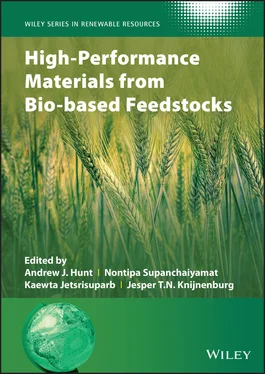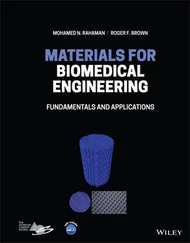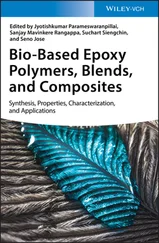High-Performance Materials from Bio-based Feedstocks
Здесь есть возможность читать онлайн «High-Performance Materials from Bio-based Feedstocks» — ознакомительный отрывок электронной книги совершенно бесплатно, а после прочтения отрывка купить полную версию. В некоторых случаях можно слушать аудио, скачать через торрент в формате fb2 и присутствует краткое содержание. Жанр: unrecognised, на английском языке. Описание произведения, (предисловие) а так же отзывы посетителей доступны на портале библиотеки ЛибКат.
- Название:High-Performance Materials from Bio-based Feedstocks
- Автор:
- Жанр:
- Год:неизвестен
- ISBN:нет данных
- Рейтинг книги:5 / 5. Голосов: 1
-
Избранное:Добавить в избранное
- Отзывы:
-
Ваша оценка:
- 100
- 1
- 2
- 3
- 4
- 5
High-Performance Materials from Bio-based Feedstocks: краткое содержание, описание и аннотация
Предлагаем к чтению аннотацию, описание, краткое содержание или предисловие (зависит от того, что написал сам автор книги «High-Performance Materials from Bio-based Feedstocks»). Если вы не нашли необходимую информацию о книге — напишите в комментариях, мы постараемся отыскать её.
High-Performance Materials from Bio-based Feedstocks
The latest advancements in the production, properties, and performance of bio-based feedstock materials
www.wiley.com/go/rrs High-Performance Materials from Bio-based Feedstocks
High-Performance Materials from Bio-based Feedstocks
High-Performance Materials from Bio-based Feedstocks — читать онлайн ознакомительный отрывок
Ниже представлен текст книги, разбитый по страницам. Система сохранения места последней прочитанной страницы, позволяет с удобством читать онлайн бесплатно книгу «High-Performance Materials from Bio-based Feedstocks», без необходимости каждый раз заново искать на чём Вы остановились. Поставьте закладку, и сможете в любой момент перейти на страницу, на которой закончили чтение.
Интервал:
Закладка:
55 55. Mazlan, M.A.F., Uemura, Y., Yusup, S. et al. (2016). Activated carbon from rubber wood sawdust by carbon dioxide activation. Procedia Engineering 148: 530–537. https://doi.org/10.1016/j.proeng.2016.06.549.
56 56. Rajgopal, S., Karthikeyan, T., Prakash Kumar, B.G. et al. (2006). Utilization of fluidized bed reactor for the production of adsorbents in removal of malachite green. Chemical Engineering Journal 116 (3): 211–217. https://doi.org/10.1016/j.cej.2005.09.026.
57 57. Prakash Kumar, B.G., Shivakamy, K., Miranda, L.R. et al. (2006). Preparation of steam activated carbon from rubberwood sawdust (Hevea brasiliensis) and its adsorption kinetics. Journal of Hazardous Materials 136 (3): 922–929. https://doi.org/10.1016/j.jhazmat.2006.01.037.
58 58. Im, U.S., Kim, J., Lee, S.H. et al. (2019). Preparation of activated carbon from needle coke via two‐stage steam activation process. Materials Letters 237: 22–25. https://doi.org/10.1016/j.matlet.2018.09.171.
59 59. Funke, A. and Ziegler, F. (2010). Hydrothermal carbonization of biomass: a summary and discussion of chemical mechanisms for process engineering. Biofuels, Bioproducts and Biorefining 4 (2): 160–177. https://doi.org/10.1002/bbb.198.
60 60. Demirbas, A. (2004). Effects of temperature and particle size on bio‐char yield from pyrolysis of agricultural residues. Journal of Analytical and Applied Pyrolysis 72 (2): 243–248. https://doi.org/10.1016/j.jaap.2004.07.003.
61 61. Titirici, M., Antonietti, M., and Baccile, N. (2008). Hydrothermal carbon from biomass: a comparison of the local structure from poly‐ to monosaccharides and pentoses/hexoses. Green Chemistry 10: 1204–1212. https://doi.org/10.1039/B807009A.
62 62. Rodríguez Correa, C., Stollovsky, M., Hehr, T. et al. (2017). Influence of the carbonization process on activated carbon properties from lignin and lignin‐rich biomasses. ACS Sustainable Chemistry & Engineering 5 (9): 8222–8233. https://doi.org/10.1021/acssuschemeng.7b01895.
63 63. Bhat, V.V., Contescu, C.I., and Gallego, N.C. (2009). The role of destabilization of palladium hydride in the hydrogen uptake of Pd‐containing activated carbons. Nanotechnology 20 (20): 204011. https://doi.org/10.1088/0957‐4484/20/20/204011.
64 64. Fuertes, A.B., Arbestain, M.C., Sevilla, M. et al. (2010). Chemical and structural properties of carbonaceous products obtained by pyrolysis and hydrothermal carbonisation of corn stover. Australian Journal of Soil Research 48 (7): 618–626. https://doi.org/10.1071/SR10010.
65 65. Dai, L., Chang, D.W., Baek, J.‐B. et al. (2012). Carbon nanomaterials for advanced energy conversion and storage. Micro and Nano: No Small Matter 8 (8): 1130–1166. https://doi.org/10.1002/smll.201101594.
66 66. Dreyer, D.R., Ruoff, R.S., and Bielawski, C.W. (2010). From conception to realization: an historial account of graphene and some perspectives for its future. Angewandte Chemie International Edition 49 (49): 9336–9344. https://doi.org/10.1002/anie.201003024.
67 67. Georgakilas, V., Otyepka, M., Bourlinos, A.B. et al. (2012). Functionalization of graphene: covalent and non‐covalent approaches, derivatives and applications. Chemical Reviews. American Chemical Society 112 (11): 6156–6214. https://doi.org/10.1021/cr3000412.
68 68. Lee, H.C., Liu, W.W., Chai, S.P. et al. (2017). Review of the synthesis, transfer, characterization and growth mechanisms of single and multilayer graphene. RSC Advances 7 (26): 15644–15693. https://doi.org/10.1039/C7RA00392G.
69 69. Zhao, G., Wen, T., Chen, C. et al. (2012). Synthesis of graphene‐based nanomaterials and their application in energy‐related and environmental‐related areas. RSC Advances 2 (25): 9286–9303. https://doi.org/10.1039/C2RA20990J.
70 70. Gao, M., Pan, Y., Huang, L. et al. (2011). Epitaxial growth and structural property of graphene on Pt(111). Applied Physics Letters 98 (3): 33101. https://doi.org/10.1063/1.3543624.
71 71. Hernandez, Y., Nicolosi, V., Lotya, M. et al. (2008). High‐yield production of graphene by liquid‐phase exfoliation of graphite. Nature Nanotechnology 3 (9): 563–568. https://doi.org/10.1038/nnano.2008.215.
72 72. Moon, I.K., Lee, J., Ruoff, R.S., and Lee, H. (2010). Reduced graphene oxide by chemical graphitization. Nature Communications 1 (1): 73. https://doi.org/10.1038/ncomms1067.
73 73. Wang, H., Li, Z., and Mitlin, D. (2014). Tailoring biomass‐derived carbon nanoarchitectures for high‐performance supercapacitors. ChemElectroChem 1 (2): 332–337. https://doi.org/10.1002/celc.201300127.
74 74. Wang, Y., Zheng, Y., Xu, X. et al. (2011). Electrochemical delamination of CVD‐grown graphene film: toward the recyclable use of copper catalyst. ACS Nano 5 (12): 9927–9933. https://doi.org/10.1021/nn203700w.
75 75. Shams, S.S., Zhang, L.S., Hu, R. et al. (2015). Synthesis of graphene from biomass: a green chemistry approach. Materials Letters 161: 476–479. https://doi.org/10.1016/j.matlet.2015.09.022.
76 76. Du, Q.S., Li, D.P., Long, S.Y. et al. (2018). Graphene like porous carbon with wood‐ear architecture prepared from specially pretreated lignin precursor. Diamond and Related Materials 90: 109–115. https://doi.org/10.1016/j.diamond.2018.10.011.
77 77. Shi, J., Wang, Y., Du, W. et al. (2016). Synthesis of graphene encapsulated Fe3C in carbon nanotubes from biomass and its catalysis application. Carbon 99: 330–337. https://doi.org/10.1016/j.carbon.2015.12.049.
78 78. Dumesic, J.A., Huber, G.W., and Boudart, M. (2008). Principles of heterogeneous catalysis. In: Handbook of Heterogeneous Catalysis (ed. G. Ertl, H. Knözinger, F. Schüth and J. Weitkamp). Online. Wiley https://doi.org/10.1002/9783527610044.hetcat0001.
79 79. Chen, J., Wang, M., Wang, S. et al. (2018). Hydrogen production via steam reforming of acetic acid over biochar‐supported nickel catalysts. International Journal of Hydrogen Energy 43 (39): 18160–18168. https://doi.org/10.1016/j.ijhydene.2018.08.048.
80 80. Liu, W.J., Jiang, H., and Yu, H.Q. (2015). Development of biochar‐based functional materials: toward a sustainable platform carbon material. Chemical Reviews 115 (22): 12251–12285. https://doi.org/10.1021/acs.chemrev.5b00195.
81 81. Chellappan, S., Nair, V., Sajith, V. et al. (2018). Synthesis, optimization and characterization of biochar based catalyst from sawdust for simultaneous esterification and transesterification. Chinese Journal of Chemical Engineering 26 (12): 2654–2663. https://doi.org/10.1016/j.cjche.2018.02.034.
82 82. Weber, K. and Quicker, P. (2018). Properties of biochar. Fuel 217: 240–261. https://doi.org/10.1016/j.fuel.2017.12.054.
83 83. Zhao, S.X., Ta, N., and Wang, X.D. (2017). Effect of temperature on the structural and physicochemical properties of biochar with apple tree branches as feedstock material. Energies 10 (9): https://doi.org/10.3390/en10091293.
84 84. Vidal, J.L., Andrea, V.P., MacQuarrie, S.L., and Kerton, F.M. (2019). Oxidized biochar as a simple renewable catalyst for the production of cyclic carbonates from carbon dioxide and epoxides. ChemCatChem 11 (16): 4089–4095. https://doi.org/10.1002/cctc.201900290.
85 85. Cao, X., Sun, S., and Sun, R. (2017). Application of biochar‐based catalysts in biomass upgrading: a review. RSC Advances 7 (77): 48793–48805. https://doi.org/10.1039/c7ra09307a.
86 86. Chia, C.H., Gong, B., Joseph, S.D. et al. (2012). Imaging of mineral‐enriched biochar by FTIR, Raman and SEM‐EDX. Vibrational Spectroscopy 62: 248–257. https://doi.org/10.1016/j.vibspec.2012.06.006.
87 87. Lin, Y., Munroe, P., Joseph, S. et al. (2012). Nanoscale organo‐mineral reactions of biochars in ferrosol: an investigation using microscopy. Plant and Soil 357 (1–2): 369–380. https://doi.org/10.1007/s11104‐012‐1169‐8.
Читать дальшеИнтервал:
Закладка:
Похожие книги на «High-Performance Materials from Bio-based Feedstocks»
Представляем Вашему вниманию похожие книги на «High-Performance Materials from Bio-based Feedstocks» списком для выбора. Мы отобрали схожую по названию и смыслу литературу в надежде предоставить читателям больше вариантов отыскать новые, интересные, ещё непрочитанные произведения.
Обсуждение, отзывы о книге «High-Performance Materials from Bio-based Feedstocks» и просто собственные мнения читателей. Оставьте ваши комментарии, напишите, что Вы думаете о произведении, его смысле или главных героях. Укажите что конкретно понравилось, а что нет, и почему Вы так считаете.












